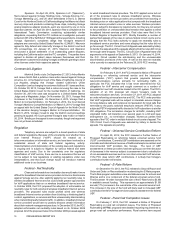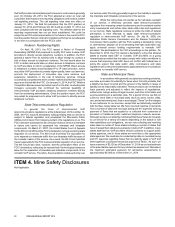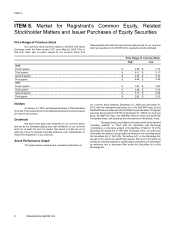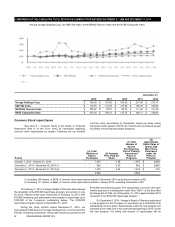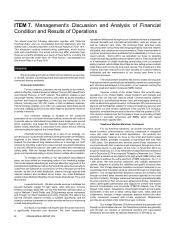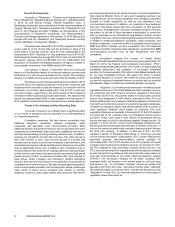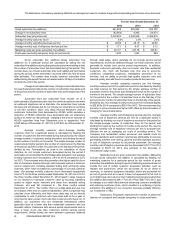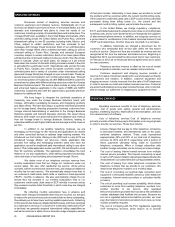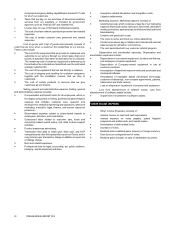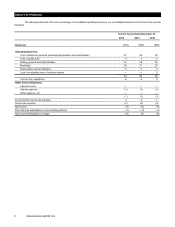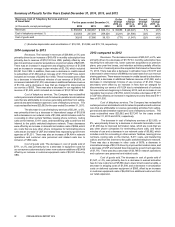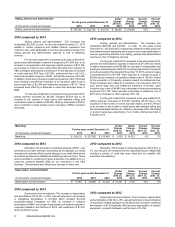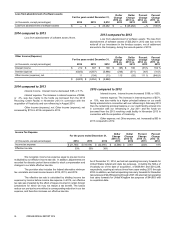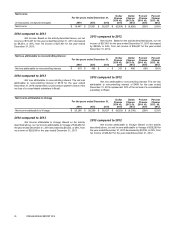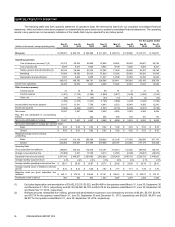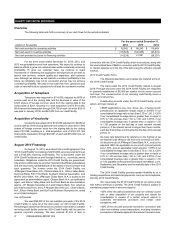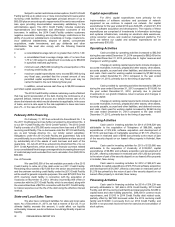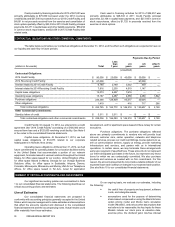Vonage 2014 Annual Report Download - page 33
Download and view the complete annual report
Please find page 33 of the 2014 Vonage annual report below. You can navigate through the pages in the report by either clicking on the pages listed below, or by using the keyword search tool below to find specific information within the annual report.
Table of Contents
29 VONAGE ANNUAL REPORT 2014
OPERATING REVENUES
Revenues consist of telephony services revenue and
customer equipment and shipping revenue. Substantially all of our
revenues are telephony services revenue. In the United States, we offer
domestic and international rate plans to meet the needs of our
customers, including a variety of residential plans and mobile plans. The
“Vonage World” plan, available in the United States and Canada, offers
unlimited calling across the United States and Puerto Rico, unlimited
international calling to over 60 countries including India, Mexico, and
China, subject to certain restrictions, and free voicemail to text
messages with Vonage Visual Voicemail. Each of our unlimited plans
other than Vonage World offers unlimited domestic calling as well as
unlimited calling to Puerto Rico, Canada, and selected European
countries, subject to certain restrictions. Each of our basic plans offers
a limited number of domestic calling minutes per month. We offer similar
plans in Canada. Under our basic plans, we charge on a per minute
basis when the number of domestic calling minutes included in the plan
is exceeded for a particular month. International calls (except for calls
to Puerto Rico, Canada and certain European countries under our
unlimited plans and a variety of countries under international calling
plans and Vonage World) are charged on a per minute basis. These per
minute fees are not included in our monthly subscription fees. Through
our recent acquisition of Vocalocity, we offer SMB and SOHO customers
several service plans with different pricing structures under the Vonage
Business Solutions brand. The service plans include an array of basic
and enhanced features applicable to the needs of SMB and SOHO
customers. Customers also have the opportunity to purchase premium
features for additional fees.
We have begun to integrate the combined operations of
Vocalocity, now under the Vonage Business Solutions brand, with
Vonage, eliminating overlapping processes and integrating products
and sales efforts. We have also begun to optimize lead flow generated
by the Vonage brand, directing prospective business customers from
Vonage inbound telemarketing or websites to the Vonage Business
Solutions website and inbound telesales channels. We expect these
efforts to shift certain core gross subscriber line additions and revenue
from the Vonage brand to Vonage Business Solutions, leading to
subscriber additions with higher total lines and average monthly revenue
per line.
In addition to our landline telephony business, we are
leveraging our technology to offer services and applications for mobile
and other connected devices to address large existing markets. We
introduced our first mobile offering in late 2009 and in early 2012 we
introduced Vonage Mobile, our all-in-one mobile application that
provides free calling and messaging between users who have the
application, as well as traditional paid international calling to any other
phone. This mobile application works over WiFi, 3G and 4G and in more
than 90 countries worldwide. The application consolidates the best
features of our prior applications, while adding important functionality,
value and ease of use including direct payment through iTunes.
We derive most of our telephony services revenue from
monthly subscription fees that we charge our customers under our
service plans. We also offer residential fax service, virtual phone
numbers, toll free numbers and other services, and charge an additional
monthly fee for each service. We automatically charge these fees to
our customers’ credit cards, debit cards, or electronic check payments
(“ECP”), monthly in advance. We also automatically charge the per
minute fees not included in our monthly subscription fees to our
customers’ credit cards, debit cards or ECP monthly in arrears unless
they exceed a certain dollar threshold, in which case they are charged
immediately.
By collecting monthly subscription fees in advance and
certain other charges immediately after they are incurred, we are able
to reduce the amount of accounts receivable that we have outstanding,
thus allowing us to have lower working capital requirements. Collecting
in this manner also helps us mitigate bad debt losses, which are recorded
as a reduction to revenue. If a customer’s credit card, debit card or ECP
is declined, we generally suspend international calling capabilities as
well as the customer’s ability to incur domestic usage charges in excess
of their plan minutes. Historically, in most cases, we are able to correct
the problem with the customer within the current monthly billing cycle.
If the customer’s credit card, debit card or ECP could not be successfully
processed during three billing cycles (i.e., the current and two
subsequent monthly billing cycles), we terminate the account.
In the United States, we charge regulatory, compliance,
E-911, and intellectual property-related recovery fees on a monthly basis
to defray costs, and to cover taxes that we are charged by the suppliers
of telecommunications services. In addition, we recognize revenue on
a gross basis for contributions to the Federal Universal Service Fund
(“USF”) and related fees. All other taxes are recorded on a net basis.
In addition, historically, we charged a disconnect fee for
customers who terminated their service plan within the first twelve
months of service. Disconnect fees are recorded as revenue and are
recognized at the time the customer terminates service. Beginning in
September 2010, we eliminated the disconnect fee for new customers.
In February of 2012 we re-introduced service agreements as an option
for new customers.
Telephony services revenue is offset by the cost of certain
customer acquisition activities, such as rebates and promotions.
Customer equipment and shipping revenue consists of
revenue from sales of customer equipment to our wholesalers or directly
to customers and retailers. In addition, customer equipment and
shipping revenues include revenues from the sale of VoIP telephones
in order to access our small and medium business services. Customer
equipment and shipping revenue also includes the fees, when collected,
that we charge our customers for shipping any equipment to them.
OPERATING EXPENSES
Operating expenses consists of cost of telephony services,
royalties, cost of goods sold, selling, general and administrative
expense, marketing expense, depreciation and amortization, and loss
from abandonment of software.
Cost of telephony services. Cost of telephony services
primarily consists of fees that we pay to third parties on an ongoing basis
in order to provide our services. These fees include:
> Access charges that we pay to other telephone companies
to terminate domestic and international calls on the public
switched telephone network. These costs represented
approximately 49% and 52% of our total cost of telephony
services for 2014 and 2013, respectively, with a portion of
these payments ultimately being made to incumbent
telephone companies. When a Vonage subscriber calls
another Vonage subscriber, we do not pay an access charge.
> The cost of leasing Internet transit services from multiple
Internet service providers. This Internet connectivity is used
to carry VoIP session initiation signaling and packetized audio
media between our subscribers and our regional data centers.
> The cost of leasing from other telephone companies the
telephone numbers that we provide to our customers. We
lease these telephone numbers on a monthly basis.
> The cost of co-locating our regional data connection point
equipment in third-party facilities owned by other telephone
companies, Internet service providers or collocation facility
providers.
> The cost of providing local number portability, which allows
customers to move their existing telephone numbers from
another provider to our service. Only regulated
telecommunications providers have access to the centralized
number databases that facilitate this process. Because we
are not a regulated telecommunications provider, we must
pay other telecommunications providers to process our local
number portability requests.
> The cost of complying with the FCC regulations regarding
VoIP emergency services, which require us to provide


